Wild About Texas – February, 2010
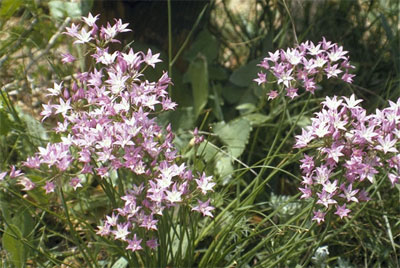
Drummond’s onion (Allium drummondii) is one of several native species that are apt to suffer from unraked leaves around their bases. See Tip 9. Photo by Robert L. Stone.
“Dirty Dozen” Clean-Up Tips for Spring
I get a lot of questions about garden maintenance, particularly relating to cutting plants back. It’s time now for trimming and for other tasks, too, as winter transitions into spring. Below is a quick and “dirty” list of chores related specifically to gardening with our state’s native flora. Keep an eye out for additional general gardening resources such as Neil’s useful “Timely Tips” in this publication and “Season to Season” in his GARDENS magazine.
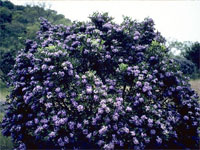
Tip 1: Texas mountain laurel (Sophora secundiflora). Photo by Annie Paulson Gillespie.
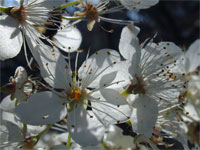
Tip 1: Mexican plum (Prunus Mexicana). Photo by Joseph A. Marcus.
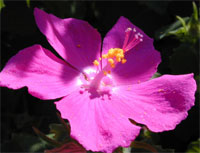
Tip 2: Pavonia (Pavonia lasiopetala). Photo by Joseph A. Marcus.
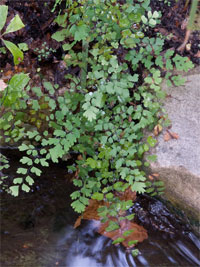
Tip 3: Maidenhair fern (Adiantum capillus-veneris). Photo by Bruce Leander.
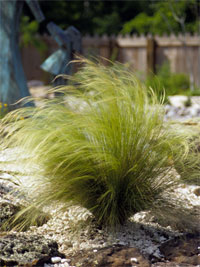
Tip 4: Mexican feather grass (Nassella tenuissima). Photo by Sally and Andy Wasowski.
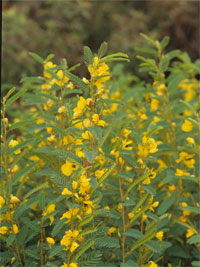
Tip 7: Partridge pea (Chamaecrista fasciculate). Photo by Sally and Andy Wasowski.
1. Now is your last chance to prune deciduous trees and shrubs before spring. After leaf break, branches are heavier, and it is harder to see what the results of your cuts will look like. For both deciduous and evergreen species, cutting branches after they put out new growth wastes the energy of the plant. If you plan on removing large amounts from spring-blooming plants, it may be best to wait until they have finished blooming (or setting fruit, if that is your goal). The wait is for aesthetic benefit rather than a requirement for tree health. Examples of plants to prune later are Texas mountain laurel (Sophora secundiflora), agarita (Mahonia trifoliolata), and Mexican plum (Prunus mexicana).
2. Semi-woody perennials like rock rose pavonia (Pavonia lasiopetala), lantanas, shrubby boneset (Ageratina havanensis) and Turk’s cap (Malvaviscus arboreus) should be cut back to living tissue, which may mean just the tips in some cases, or within 3 to 4 inches from the ground in others. Cherry or autumn sage (Salvia greggii) performs best if you take out the woodiest branches all the way to the main stem and then shape the remaining new growth.
3. Snip or pull off all dead leaves from herbaceous plants before new growth emerges in spring and makes the dead growth difficult to surgically remove without damaging desirable foliage. Examples include plants like maidenhair fern (Adiantum capillus-veneris), mealy blue sage (Salvia farinacea), and clump grasses — except for muhlys (Muhlenbergia spp.) and Mexican feathergrass. Remove herbaceous vines from fences and trellises.
4. Feathergrass (Nassella tenuissima), Gulf muhly (M. capillaris), Lindheimer or big muhly (M. lindheimeri), seep muhly (M. reverchonii) and relatives do not completely die back in winter and are slow to recover if sheared, taking years for the “ghost” cut to disappear. In some cases, cutting these grasses back may even kill the plant. Instead, break off brittle flower stalks by hand and take a leaf rake to groom the rest. If plants are congested with dead leaves, lift up the lower blades to pull out any loose clumps from underneath.
5. Tidy up dead and marred foliage from perennials with evergreen rosettes that have endured the winter. Examples include purple coneflower (Echinacea purpurea), giant coneflower (Rudbeckia maxima), and big red sage (Salvia penstemonoides).
6. Although spring fever drives us to plant all season long, new sets will be best equipped for summer’s heat and dryness the earlier they get in the ground and start growing roots. Finish planting the bulk of your new installations now.
7. March and April are good times to start from seed warm-season grasses, perennials, and annuals like side oats grama (Bouteloua curtipendula), Mexican hat (Ratibida columnifera), and partridge pea (Chamaechrista fasciculata). Rake away any excess mulch from areas on which you plan to sow, being sure to achieve sufficient soil-to-seed contact.
8. Pull weeds! Henbit (Lamium amplexicaule), annual bluegrass (Poa annuua), sow thistle (Sonchus spp.), prickly lettuce (Lactuca spp.), bur clover (Medicago sp.), and white sweet clover and yellow clover (Melilotus spp.) are all rampant during cool months. Hone your search images for these pests and dig them out before they drop seed. You’ll have a whole lot less to deal with next year if you do.
9. Rake up thick layers of leaves from around plants that need to “breathe,” like Blackfoot daisies (Melampodium leucanthum), golden groundsel (Packera obovata) and Drummond onions (Allium drummondii). Dense and moist leaf mold can smother and rot sensitive species.
10. Refresh mulch where appropriate, keeping in mind that wildflower seeds should not be mulched, and some xeric species like those native to Central Texas may appreciate mineral mulches like pea gravel, decomposed granite, or crushed glass to reduce humidity around the plants.
11. Even though we’ve had a moist winter, check in advance of warmer weather to see that your irrigation system is working properly. Repair leaks and readjust head angles.
12. Be sure to talk to your bluebonnets regularly throughout the spring. They really like that!
For more information about Texas native plants, visit the Wildflower Center’s website at www.wildflower.org.
About the author: Andrea DeLong-Amaya is the director of horticulture at the Lady Bird Johnson Wildflower Center in Austin.

